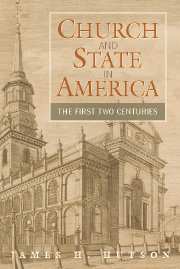Series Editor's Foreword
Published online by Cambridge University Press: 05 June 2012
Summary
The First Amendment to the Constitution, embodied in the Bill of Rights proposed by Congress in 1789 and ratified by three-fourths of the states in 1791, concerned religion. The amendment simply states, “Congress shall make no law respecting an establishment of religion, or prohibiting the free exercise thereof.” This amendment prevented the federal government from establishing a national religion and allowed people to freely exercise their religious beliefs and practices. The amendment appeared straightforward, but in practice it was ambiguous and increasingly controversial.
The establishment clause – that Congress shall make no law respecting the establishment of religion – appears at a minimum to prevent the newly established federal government from granting any denomination or religious sect the privileges enjoyed in England by the Anglican Church or in other European nations by the Roman Catholic Church. The amendment was not intended, it appears, to do away with established religious denominations then exsting in the states. The question of state-established churches was left to the states.
Similarly, the free exercise clause was intended to prevent governmental persecution of dissenting religious sects and denominations as was common in England and other European countries. Congress probably intended the free exercise clause to prevent the federal government from imposing civil penalties on religious dissenters; nevertheless, even after ratification of the First Amendment, many states continued to impose civil restrictions on non-Protestants and atheists.
Throughout the nineteenth century the First Amendment drew little attention from the courts.
- Type
- Chapter
- Information
- Church and State in AmericaThe First Two Centuries, pp. ix - xiiPublisher: Cambridge University PressPrint publication year: 2007



